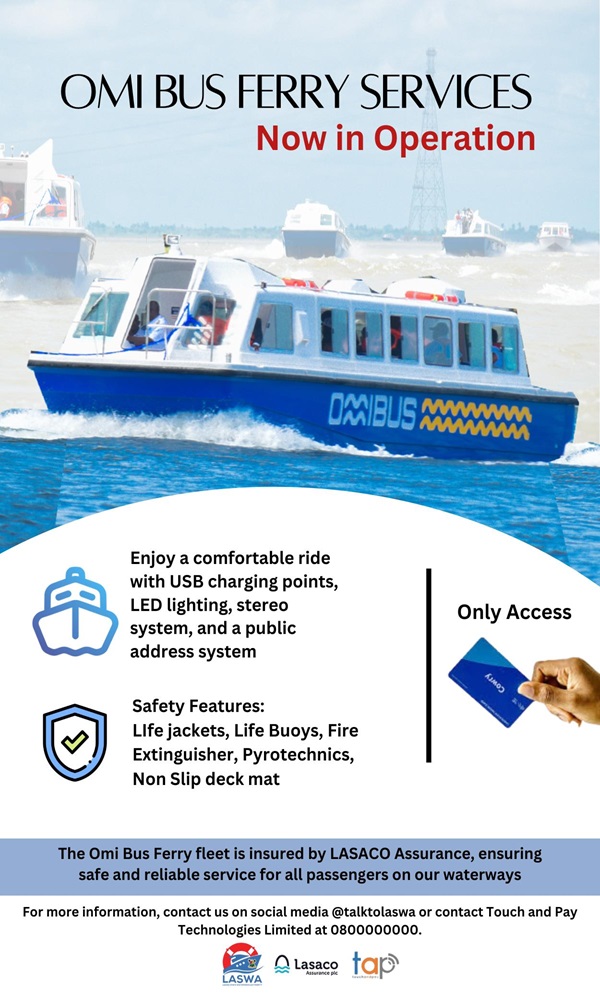Lagos State Government began the most critical leg of the Red Line component of its Lagos Rail Mass Transit (LRMT) on Monday, with the flag-off of non-paying passenger service between Oyingbo and Agbado, in Ogun State.
The train made the end-to-end trip from Oyingbo to Agbado in one hour seven minutes, and that is even as it made a three-minutes stop at the seven train stations on the route, where it either dropped some passengers or from when new passengers boarded the new train.
The state government constructed modern stations at Oyingbo, (where it also has a stabling yard), Yaba, Mushin, Oshodi, and Ikeja. Others are; Agege, Iju, and Agbado, (where another stabling yard is in the works). The Oshodi Station is grafted with the Terminal Three of the BRT interchange built by the state government.
The Red Line is a Diesel Multiple Unit (DMU) twin locomotive engine with five coaches fitted with modern amenities, and comfortable seats and a secured and safe ambience that offers reliable, comfortable, safe and predictable transport alternatives.
On Tuesday, LAMATA, which commenced commercial activity on the Blue line exactly a year ago, said the Electric line carried two million passengers in its first 12 months of operation.
Some of the passengers who spoke with our correspondent, were full of praise for the Lagos State Government for providing commuters with alternative modes of transportation and ensuring that it delivers on the second flagship train project by any sub-national in Nigeria.
The Consultant, Corporate Communication with LAMATA, Mr Kolawole Ojelabi, described the project as epochal and symbolizes the renewed spirit of Lagos under the THEMES+ Agenda of the Babajide Sanwo-Olu administration.
“LAMATA salutes the commitment of the Lagos State Governor Mr Babajide Sanwo-Olu who was unrelenting in his determination to see to the delivery of the project. The backing we received from the state governor informed the commitment with which LAMATA’s Managing Director Engr Abimbola Akinajo not to leave any stone unturned in delivering this project to the good people of Lagos,” Ojelabi said.
Abdulganiyu Tyson, an engineer with Nexant Construction Ltd., the consulting firm that supervised the project said outside the initial hiccups witnessed during the take-off phase, the contractor encountered no major challenge throughout the construction phase. He applauded the state government for coming up with the provision of alternative modes of transportation to the people of the state.
He said: “Being a corridor that belonged to the NRC, sometimes we attend strategy meetings as well as stakeholders’ engagements with our client and I must say that we never encountered any issue whatsoever, even in settlement of claims and payment of compensations to those whose property are directly impacted by the project.”
Another engineer, Adebola Adeyemo, also with Nexant corroborated Tyson, adding that the project was concluded in three years was a testament to the massive enjoyed by the contractor, and the team of people working to deliver the project.
Mrs Olaitan Oyedokun, a teacher with Baptist Girls’ Academy, Obanikoro, who got her invitation by merely applying for the non-fee paying trip online was full of praises for the Lagos State Government. Mrs Oyedokun, who lives in Igando, had boarded the train at Ikeja. She had all nice words for the state government for creating alternatives for the people of the state.
Another passenger, Miss Aminat Afolabi Oyeduni, described the train as “fast, safe, comfortable and reliable.”
The Zonal Coordinator, National Institute for Hospitality and Tourism, Lagos Campus, Mrs Chinyere Uche-Ibeabuchi, who boarded the train from Yaba, described the train as fast, reliable, and a lovely experience, in terms of tourism potentials.
As a tour enthusiast, Mrs Uche-Ibeabuchi urged the state government to continue to rid the slum and illegal squatters along the corridor as it would be unsightly to expose tourists to see this ugly face of the state once the train begins commercial operation. “As someone working in the tourism sector, that aspect of the ride is one that the government must continue to work upon,” she said.
Prince Tella Adeyemi, a 68 year-old trader living at Adiyan, said the huge passengers at Agbado are already waiting for when commercial activity on the line will commence. He said Agbado to Oshodi by road is now N1,200 urging the government to make the price of the rail competitive to encourage passenger patronage.
He also called on the government to work on security in the train and at the various stations to prevent vandals from vandalizing the utility.
Mr Anthony Olansile, a Fire Inspector with the Fire Service Station (FSS) Ojuelegba, who also applied online and got invited to experience the trial trip said the train is fast, even as it is a trial phase. He looked forward to making the Oyingbo to Agbado in about 45 minutes instead of the one hour seven minutes presently.
Director Lagos State Ministry of Commerce, Trade and Investment, Niyi Oladipo, who led a team of officials from the Ministry on the trip said the government must be applauded for bringing the Redline to life in record time. “My first impression of the Red Line is great, it is fantastic. It is noteworthy that this is happening in our lifetime. My second observation is to urge the state government to be strong on maintenance and continuity. Overall, this is very laudable and it is long overdue. So far, I am impressed with the timing and the keeping to schedule. I am sure it will surpass the 500 passenger traffic per day projected by the government for this project.” Oladipo said.
He urged the government to look into the entrance of the coaches to the platforms. He said the steps constructed on the coaches must be looked into before commercial activity finally commenced.
Ojelabi said but for some hitches, LAMATA wanted to commence operation in June or July and that was why the government after serious engagement with the NRC commenced non passenger test run of the corridor last month and free trial run last week. He added that the NRC had specified a speed limit of 45 mins, with a three-minutes stop at each station. Because we are sharing the route with the NRC, we are being mindful that we must work within our approved schedule and we hope that when we finally begin commercial operation we would be able to achieve more as we can look at making the trip end to end in 40 to 45 minutes, and reduce the stoppages at each stations from three to like two minutes.”

























